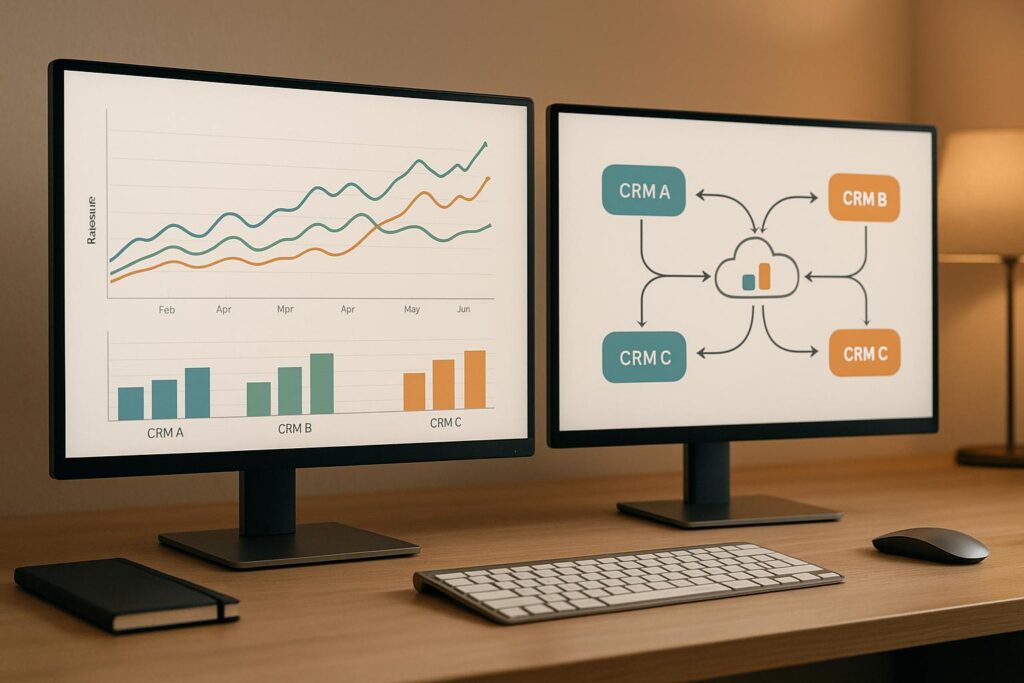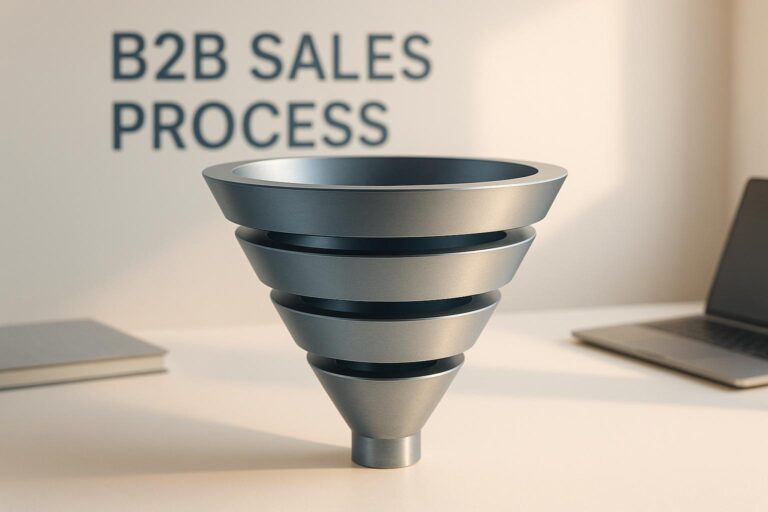Syncing revenue data across CRMs ensures consistent, accurate financial information across platforms without manual updates. This is crucial for B2B SaaS companies managing subscription-based revenue models, as fragmented data leads to errors, inefficiencies, and missed opportunities. By using API connections, integration tools, and standardized data formats, businesses can automate updates, eliminate silos, and improve reporting accuracy.
Key Points:
- Synchronization avoids manual errors, duplicate records, and reporting inconsistencies.
- Multi-CRM setups often arise from mergers, regional needs, or legacy systems, creating challenges like schema mismatches and poor data quality.
- Effective synchronization requires clear governance, standardized fields, and robust integration tools.
- AI and automation can enhance workflows, improve lead enrichment, and enable real-time reporting.
- Security measures like SOC 2 compliance and encryption are essential for protecting sensitive data.
Steps to Sync CRMs:
- Audit and standardize data fields across CRMs.
- Choose integration tools (e.g., Make.com for simple setups or n8n for advanced workflows).
- Test sync setups with small datasets and monitor for errors.
- Use AI for tasks like lead scoring, data enrichment, and pipeline updates.
- Build custom dashboards for unified, real-time revenue insights.
Synchronizing CRMs streamlines operations, improves forecasting, and supports growth while reducing compliance risks and inefficiencies.
Automation vs Sync vs ETL: Intro to Data Integration
Common Multi-CRM Scenarios and Data Problems
Let’s dive into why companies often juggle multiple CRMs and the specific data challenges this creates.
Why Companies Use Multiple CRMs
There are several reasons why businesses end up managing more than one CRM system. Mergers and acquisitions are a big one. When two companies come together, they often bring their own CRM systems with them. These systems, complete with established workflows, usually need to coexist – at least temporarily – during the transition.
Regional differences also play a role. For example, a company might use one CRM for its North American teams while relying on a different system to meet compliance or currency requirements in other regions. Then there’s the issue of legacy systems. Older, highly customized CRMs often remain in use for specific processes, while newer platforms handle day-to-day operations. This hybrid setup can be practical but adds complexity.
Common Data Problems in Multi-CRM Environments
Managing multiple CRMs can lead to a host of data challenges, often compounding existing issues. One major hurdle is schema mismatches. Each CRM may use different field names, formats, or rules. For instance, one system might store phone numbers as (555) 123-4567, while another uses 555.123.4567. These inconsistencies make it harder to match and analyze data effectively.
Data quality issues also become more pronounced. Multi-CRM environments can introduce unnecessary characters, formatting errors, and even symbols like emojis in contact records. These seemingly small issues can disrupt workflows, increase email bounce rates, and interfere with automation.
"Clay has helped Anthropic significantly improve our lead enrichment and sales data pipelines. We’ve been able to consolidate our tech stack to core essentials, like our CRM, Clay, and email tool."
– Adam Wall, Head of Revenue Operations, Anthropic
Another major issue is low data enrichment rates. When companies rely on isolated data sources within each CRM, they often struggle to gather a complete picture of their prospects and customers. Anthropic’s experience highlights this problem – they managed to triple their enrichment rate by consolidating data sources, addressing the challenges of fragmentation.
Julien Reiman, Head of Sales, also points out how unreliable data, like incorrect phone numbers or high email bounce rates, can cripple outbound campaigns. These data problems don’t just create operational headaches – they can have a ripple effect on the entire business.
Business Impact of Unsynchronized Data
The fallout from unsynchronized CRM data goes well beyond inconvenience. For starters, incomplete data undermines forecasting accuracy. Finance teams struggle to produce reliable revenue projections, making it harder to plan quarterly forecasts with confidence.
Customer experience takes a hit, too. Sales reps might unknowingly contact prospects who have already been engaged through another CRM. Meanwhile, customer success managers could miss critical updates stored in separate systems, leading to service gaps or missed opportunities for account growth.
This inefficiency also eats into productivity. Sales teams spend countless hours manually managing data, and incomplete pipeline views make revenue forecasting less reliable. As companies scale, these problems only grow, creating roadblocks for onboarding and training new team members.
Compliance risks are another major concern. Fragmented data makes it harder to enforce consistent privacy controls or maintain thorough audit trails. This can complicate responses to data subject requests and regulatory requirements, pulling resources away from more strategic initiatives.
Finally, unsynchronized data can lead to missed revenue opportunities. When information is scattered across multiple CRMs, sales teams often fail to spot cross-selling or upselling signals. This fragmentation can prevent them from maximizing revenue growth opportunities, leaving money on the table.
Requirements for Effective CRM Data Synchronization
Achieving seamless CRM data synchronization takes more than just advanced tools – it demands careful planning and meeting key requirements. Without these, even the best integration solutions can fall short, leading to inconsistent and unreliable results.
Core Prerequisites for Revenue Data Synchronization
To ensure smooth data synchronization, start with clear data governance policies. These should define who owns the data, how conflicts are resolved, and how duplicates are managed. Without such policies, teams risk overwriting each other’s updates or creating conflicting records, which can compromise data accuracy.
Consistency is another critical factor. Standardize field formats, naming conventions, and validation rules across all your CRMs. For example, use a uniform format for phone numbers and currencies to avoid mismatches.
Adding safeguards like error logging, retry queues, and administrator alerts can help prevent data loss during high-volume operations. Modern sales teams also rely on real-time updates for deal statuses, contact changes, and pipeline movements, making these mechanisms even more essential.
Choosing the Right Synchronization Architecture
The architecture you select shapes your system’s scalability, ease of maintenance, and overall performance. The two main options – point-to-point and hub-and-spoke – each have their strengths and weaknesses.
| Architecture Type | Pros | Cons | Best For |
|---|---|---|---|
| Point-to-Point | Easy to implement, direct data flow, lower initial cost | Becomes unmanageable with multiple CRMs, limited scalability | Companies with 2-3 CRMs and straightforward data needs |
| Hub-and-Spoke | Centralized control, scalable, consistent data transformation | Higher upfront costs, requires managing a central platform | Organizations with 4+ CRMs, complex workflows, or growth plans |
If you’re working with just two or three CRMs, a point-to-point setup may suffice. It creates simple, direct connections between systems, making it easy to understand and troubleshoot. However, as the number of CRMs increases, the complexity grows exponentially, turning maintenance into a daunting task.
For larger setups or more complex workflows, a hub-and-spoke architecture is a better fit. Here, a central hub manages all data flows, handling tasks like data transformation, routing, and conflict resolution. While it requires more advanced tools and management, it scales efficiently and supports growing organizations.
Next, we’ll explore the security measures necessary for compliant data synchronization.
Compliance with U.S. Data Privacy Standards
Synchronizing revenue data across multiple systems requires strict adherence to data privacy standards. SOC 2 Type II compliance is widely recognized as the benchmark for ensuring security, availability, processing integrity, confidentiality, and privacy throughout the process.
The California Consumer Privacy Act (CCPA) imposes specific obligations, such as supporting opt-out requests and maintaining Do Not Call (DNC) lists across all synchronized systems. For revenue data synchronization, you need mechanisms that enforce these preferences consistently.
"Support your customer base with opt out and DNC support." – Clay
Security is non-negotiable. Use encryption for all data transfers and implement Single Sign-On (SSO) to restrict access to authorized personnel only. These measures are especially critical when dealing with sensitive revenue data, which often includes customer information and competitive insights.
If you’re connecting CRMs to third-party platforms, ISO 27001 compliance provides an additional layer of assurance. This standard ensures that appropriate security controls are in place for all system connections.
"Securely connect your CRM and other systems." – Clay
Even though GDPR compliance is a European regulation, many U.S. companies adopt its principles globally to demonstrate strong data protection practices. Implementing GDPR-level safeguards can also prepare your business for international expansion while providing a competitive edge domestically.
When using third-party synchronization tools, it’s essential to evaluate where and how they store your data. Ensure these providers meet U.S. regulatory requirements and maintain robust security standards.
sbb-itb-647c22e
Step-by-Step Guide to Syncing Revenue Data Across CRMs
Now that you’ve got a handle on the requirements and architectural options, it’s time to roll up your sleeves and start building your revenue data synchronization system. This process demands careful planning to ensure your data flows smoothly and accurately between CRMs.
Mapping and Standardizing Data Across CRMs
Start by auditing all your CRM systems to catalog field names, data types, and validation rules. Document and standardize key revenue data fields – like deal values and close dates – to avoid mismatches. Pay special attention to custom fields in each CRM, as these can often be the source of synchronization hiccups.
Currency formats need to match. For example, if your HubSpot CRM uses the USD format ($10,000.00) but Salesforce has a different setup, decide on a single standard that aligns with your primary reporting currency. This avoids calculation errors down the road.
Create a master data dictionary to define formatting rules across all CRMs. For instance:
- Use consistent phone number formats, like (555) 123-4567.
- Standardize dates in the MM/DD/YYYY format.
- Align deal stages with clear, uniform names like "Qualified", "Proposal", and "Closed Won."
Finally, tackle duplicate records before syncing. Run deduplication processes in each CRM to merge duplicate contacts, companies, and deals. This avoids messy data overwrites or additional duplicates during synchronization.
Selecting and Configuring Integration Tools
Once your data is standardized, it’s time to choose the right integration tools. The tool you pick should preserve your formatting and handle mapping with ease.
For simpler needs, no-code platforms like Make.com offer an intuitive interface. If your setup is more complex and requires advanced workflows, n8n provides custom logic and data transformation capabilities.
Set up field-to-field connections within your integration tool. This includes mapping fields between CRMs, applying currency conversions, and configuring encryption for secure data transfers. Be sure to implement Single Sign-On (SSO) and ensure the platform meets compliance standards like SOC 2 Type II and GDPR.
To handle tricky scenarios, configure conditional logic. For example, decide whether the most recently updated record takes precedence or if specific CRMs should be the authoritative source for certain types of data. AI-powered cleaning tools can also help maintain consistency during synchronization.
Once your tools are configured, testing and error management will be key to keeping everything running smoothly.
Testing, Monitoring, and Error Handling
Use your master data dictionary as a guide and start testing with a small dataset – around 50 to 100 records. Set up real-time dashboards to monitor sync status and error rates. Include automated error retries with fallback logic to handle issues as they arise. It’s also wise to document rollback procedures to restore data if sync errors occur.
Set up alerts for sync failures, data conflicts, or unusual patterns. Notifications should go to the right team members so they can address problems quickly before they escalate.
Keep an eye on sync performance metrics like processing speed, success rates, and data accuracy, especially during high-traffic periods. This can help you spot bottlenecks before they disrupt daily operations.
Finally, test edge cases. Simulate scenarios like network interruptions, API rate limits, or simultaneous record updates from multiple users. These tests ensure your system can handle unexpected challenges without crashing in a live environment.
Engineering-Backed Solutions and Automation Strategies
Basic integration tools might handle simple CRM synchronization, but engineering-backed automation takes revenue data management to an entirely new level. These advanced solutions don’t just move data – they reshape how B2B SaaS companies approach their go-to-market (GTM) strategies.
Why Engineering-Backed GTM Automation Matters
Unlike standard tools, engineering-backed automation creates systems that align with your business needs. For example, SixtySixTen has enabled GTM teams to boost revenue by 30% and operate 2.5x more efficiently across more than 100 customers globally. These results come from eliminating manual processes and implementing automation tailored to specific business rules.
A key advantage is flexibility. Instead of forcing your team to adjust to rigid software, these systems adapt to your workflows. For instance, if your company struggles with complex revenue attribution across multiple product lines, custom solutions can handle these challenges by applying rules designed specifically for your business.
Scalability is another game-changer. As your company grows from thousands to millions of records, engineering-backed solutions handle the increased data load effortlessly. They manage tasks like data enrichment, intent signal monitoring, and CRM updates without slowing down. Advanced error handling also ensures data integrity, with features like automated conflict resolution and intelligent fallback mechanisms – even in multi-CRM setups.
This robust integration sets the stage for AI-powered improvements and real-time insights, which we’ll explore next.
AI-Driven Enhancements for CRM Workflows
AI agents are revolutionizing how revenue data moves between CRMs by automating tasks that previously required manual effort. For example, OpenAI, a Clay customer, increased its data enrichment coverage from the low 40% range to over 80% using Clay.
AI agents streamline lead management by analyzing data across CRMs, improving lead scoring, and routing qualified prospects to the right sales teams. This eliminates the need for manual cross-referencing. Verkada, another Clay customer, saved hours every week by automating lead enrichment tasks, such as company research and contact verification. The AI also analyzes intent signals and updates all connected CRMs with enriched data, ensuring sales teams have complete and accurate lead information – whether they’re using Salesforce, HubSpot, or another platform.
Another strength of AI agents is real-time data standardization. They can automatically format phone numbers (e.g., (555) 123-4567), convert currencies to USD, and standardize dates to MM/DD/YYYY as data syncs between systems. This prevents the formatting inconsistencies that often arise from manual processes.
For prospecting, AI agents monitor buying signals from over 3 million companies to prioritize outreach. When a prospect shows intent in one CRM, the AI updates records across all systems and triggers follow-up actions, ensuring no opportunity slips through the cracks.
These automated workflows feed directly into custom dashboards, providing unified, real-time revenue insights.
Custom Dashboards for Real-Time Revenue Insights
Synchronized CRM data ultimately leads to unified visibility into revenue performance. Custom dashboards built with tools like Google Looker and PowerBI pull data from multiple CRMs and display it in real-time, adhering to U.S. business standards.
These dashboards do more than aggregate data. They present revenue figures in proper USD formatting (e.g., $1,250,000.00), track deal progress with MM/DD/YYYY timestamps, and calculate conversion rates in line with American reporting conventions.
Real-time updates ensure the dashboard always reflects the latest data. For instance, when a deal closes in Salesforce, the dashboard instantly updates revenue projections, pipeline metrics, and team performance stats – no waiting for overnight batch processes.
What sets these dashboards apart is their ability to handle complex KPI calculations across multiple CRMs. If enterprise deals are tracked in Salesforce and SMB deals in HubSpot, the dashboard can calculate blended conversion rates, average deal sizes, and revenue attribution that accounts for both systems.
By integrating with data warehouses, these dashboards also support historical trend analysis. Combining years of data from different CRMs provides a comprehensive view of how revenue patterns have evolved as the business has scaled.
Lastly, automated alerts ensure stakeholders stay informed. If pipeline velocity drops, deals stall, or revenue targets are at risk, the system sends notifications with actionable insights drawn from all connected CRMs. This proactive approach helps teams address issues before they escalate.
Conclusion: Improving Revenue Operations with CRM Synchronization
Main Takeaways
Synchronizing revenue data across multiple CRMs can transform how B2B SaaS companies operate and grow. Companies that adopt CRM automation report up to a 30% increase in revenue and a 2.5× boost in productivity. This shift can redefine how businesses approach operational efficiency.
The real game-changer lies in going beyond basic data transfer and embracing engineering-backed automation systems. For instance, Anthropic achieved full automation in Salesforce, and GoJob saw a 50% jump in yearly net revenue by automating workflows and streamlining operations with Make in December 2024.
"We help Go-to-Market teams close more deals by automating lead qualification, enrichment, pipeline management, and CRM workflows." – SixtySixTen
Real-time data syncing ensures live updates across CRMs, enabling faster decision-making. AI-driven automation takes care of complex tasks like lead scoring, data enrichment, and pipeline management. Meanwhile, custom dashboards provide a unified view across systems, making it easier to track progress and spot opportunities.
By leveraging no-code and custom solutions, businesses can automate lead qualification and pipeline management with ease. These tools are built to scale, handling growth from thousands to millions of records. This lets GTM teams focus on closing deals while automation simplifies the operational workload.
Next Steps for Businesses
To harness the benefits of CRM synchronization, businesses can take a few practical steps. As highlighted earlier, robust integration and automation are essential for overcoming the challenges of managing multiple CRMs.
Start by evaluating your current CRM systems to pinpoint inefficiencies and data fragmentation. Identify manual processes that slow your team down or areas where inconsistent data formats cause confusion. Documenting these issues will help shape your automation strategy.
Explore AI-driven automation platforms with extensive integration capabilities. For example, Make connects with over 3,000 apps, while Clay integrates with 150+ data providers. These platforms excel at automating tasks like lead qualification, data enrichment, and pipeline management across multiple CRMs.
AI tools can also handle tasks such as auto-formatting phone numbers to standard formats like ((555) 123-4567), converting currencies into USD, and standardizing dates – all while reducing manual errors.
Work with GTM automation specialists to ensure you choose the right tools and strategies tailored to your business needs. Adam Wall, Head of Revenue Operations at Anthropic, shared his experience:
"Clay has helped Anthropic significantly improve our lead enrichment and sales data pipelines"
Finally, prioritize platforms with strong security credentials such as GDPR, SOC 2 Type II, and CCPA compliance to maintain data integrity and build trust . Create workflows that are flexible and easy to refine, allowing for quick adjustments and turning insights into timely actions across your tech stack.
FAQs
What challenges arise when syncing revenue data across multiple CRMs, and how can they be solved?
Synchronizing revenue data across multiple CRMs can feel like trying to piece together a puzzle with mismatched pieces. Common hurdles include keeping data consistent, ensuring real-time updates, and avoiding manual mistakes. These challenges often disrupt sales processes, lead to inaccurate reports, and create unnecessary inefficiencies.
The solution? Automation. By introducing systems designed to streamline workflows and unify data, businesses can ditch manual tasks and achieve smooth, error-free synchronization. SixtySixTen is a trusted partner in this space, offering automation solutions tailored for B2B SaaS companies. Using a mix of no-code/low-code tools and custom development, they help transform revenue operations. Their approach not only optimizes CRM workflows and boosts data visibility but also ensures your operations run efficiently while scaling to match your growth.
How can AI improve CRM data synchronization and automate key processes?
AI transforms how businesses handle CRM data synchronization by automating and simplifying tasks that usually demand manual effort. It ensures real-time updates, enhances data accuracy, and minimizes errors.
Here’s how AI can streamline CRM processes:
- Lead scoring, enrichment, and segmentation: AI helps prioritize and organize contacts, making it easier to focus on the most promising leads.
- CRM updates and data management: It keeps information consistent and up-to-date across multiple systems without manual intervention.
- Outreach workflows and sales enablement: Automating these processes saves time and improves team productivity.
By integrating AI into CRM systems, businesses can refine workflows and free up teams to concentrate on more strategic, high-impact tasks.
What security measures should I take to ensure compliance when syncing revenue data across CRMs?
When syncing revenue data across CRMs, safeguarding sensitive information should be a top priority. Start by using tools and platforms that meet recognized industry standards, such as GDPR and SOC 2 Type II compliance. Make sure all data is encrypted – both when it’s being transferred and when it’s stored – and consider implementing single sign-on (SSO) to tighten access controls.
It’s also crucial to conduct regular audits of your workflows. This helps uncover any potential weak spots and ensures you’re staying up-to-date with changing regulations. Leveraging automated systems from reliable providers can further minimize risks while maintaining data accuracy and security.



